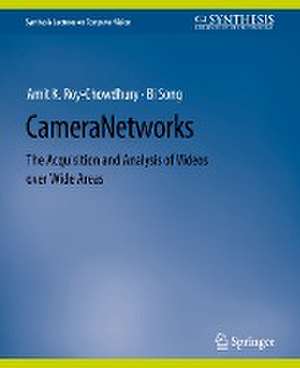Camera Networks: The Acquisition and Analysis of Videos over Wide Areas: Synthesis Lectures on Computer Vision
Autor Amit K Roy-Chowdhury, Bi Songen Limba Engleză Paperback – 27 ian 2012
Din seria Synthesis Lectures on Computer Vision
- 20%
 Preț: 353.28 lei
Preț: 353.28 lei - 20%
 Preț: 254.47 lei
Preț: 254.47 lei - 20%
 Preț: 273.49 lei
Preț: 273.49 lei - 20%
 Preț: 273.49 lei
Preț: 273.49 lei - 20%
 Preț: 277.60 lei
Preț: 277.60 lei - 20%
 Preț: 147.74 lei
Preț: 147.74 lei - 20%
 Preț: 224.50 lei
Preț: 224.50 lei - 20%
 Preț: 269.20 lei
Preț: 269.20 lei - 20%
 Preț: 224.00 lei
Preț: 224.00 lei - 20%
 Preț: 331.74 lei
Preț: 331.74 lei - 20%
 Preț: 225.67 lei
Preț: 225.67 lei - 20%
 Preț: 352.78 lei
Preț: 352.78 lei - 20%
 Preț: 354.92 lei
Preț: 354.92 lei - 20%
 Preț: 297.49 lei
Preț: 297.49 lei - 20%
 Preț: 177.47 lei
Preț: 177.47 lei - 20%
 Preț: 356.73 lei
Preț: 356.73 lei - 20%
 Preț: 294.54 lei
Preț: 294.54 lei - 20%
 Preț: 415.95 lei
Preț: 415.95 lei - 20%
 Preț: 353.43 lei
Preț: 353.43 lei - 20%
 Preț: 329.76 lei
Preț: 329.76 lei - 20%
 Preț: 383.57 lei
Preț: 383.57 lei - 20%
 Preț: 329.26 lei
Preț: 329.26 lei - 20%
 Preț: 222.50 lei
Preț: 222.50 lei - 20%
 Preț: 358.04 lei
Preț: 358.04 lei - 20%
 Preț: 240.56 lei
Preț: 240.56 lei - 20%
 Preț: 331.36 lei
Preț: 331.36 lei
Preț: 225.15 lei
Preț vechi: 281.44 lei
-20% Nou
Puncte Express: 338
Preț estimativ în valută:
43.08€ • 45.10$ • 35.86£
43.08€ • 45.10$ • 35.86£
Carte tipărită la comandă
Livrare economică 31 martie-14 aprilie
Preluare comenzi: 021 569.72.76
Specificații
ISBN-13: 9783031006838
ISBN-10: 3031006836
Ilustrații: XI, 119 p.
Dimensiuni: 191 x 235 mm
Greutate: 0.25 kg
Editura: Springer International Publishing
Colecția Springer
Seria Synthesis Lectures on Computer Vision
Locul publicării:Cham, Switzerland
ISBN-10: 3031006836
Ilustrații: XI, 119 p.
Dimensiuni: 191 x 235 mm
Greutate: 0.25 kg
Editura: Springer International Publishing
Colecția Springer
Seria Synthesis Lectures on Computer Vision
Locul publicării:Cham, Switzerland
Cuprins
An Introduction to Camera Networks.- Wide-Area Tracking.- Distributed Processing in Camera Networks.- Object and Activity Recognition.- Active Sensing.- Future Research Directions.
Notă biografică
Amit K. Roy-Chowdhury is an Associate Professor of Electrical Engineering and Cooperating Faculty in Computer Science at the University of California, Riverside. He received his PhD from the University of Maryland, College Park, in 2002. His research and teaching interests are in signal and image processing, computer vision and pattern recognition. He has been a Principal Investigator on a number of research projects related to motion analysis in video, camera networks and image analysis for biological applications, and has published over 100 technical articles on these topics.
